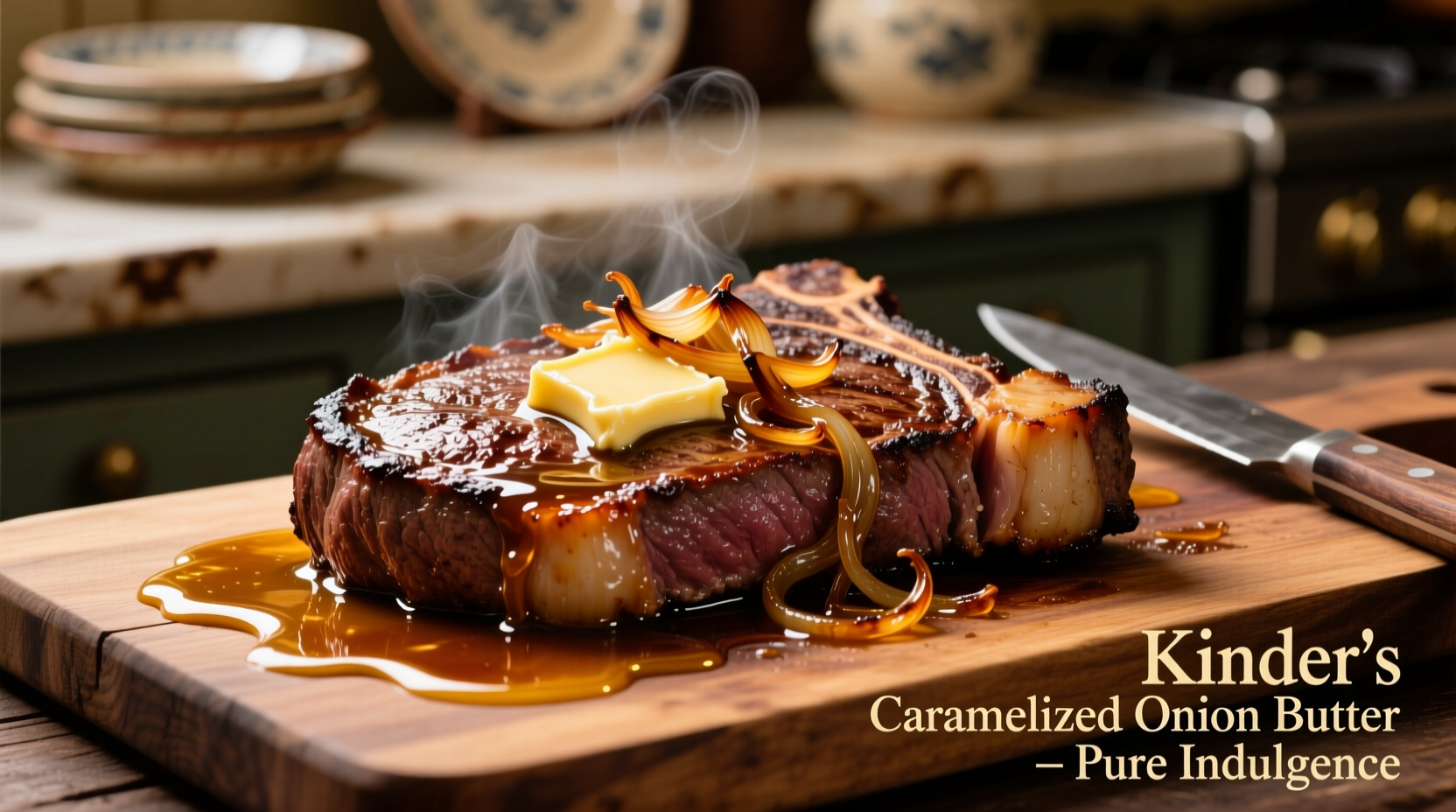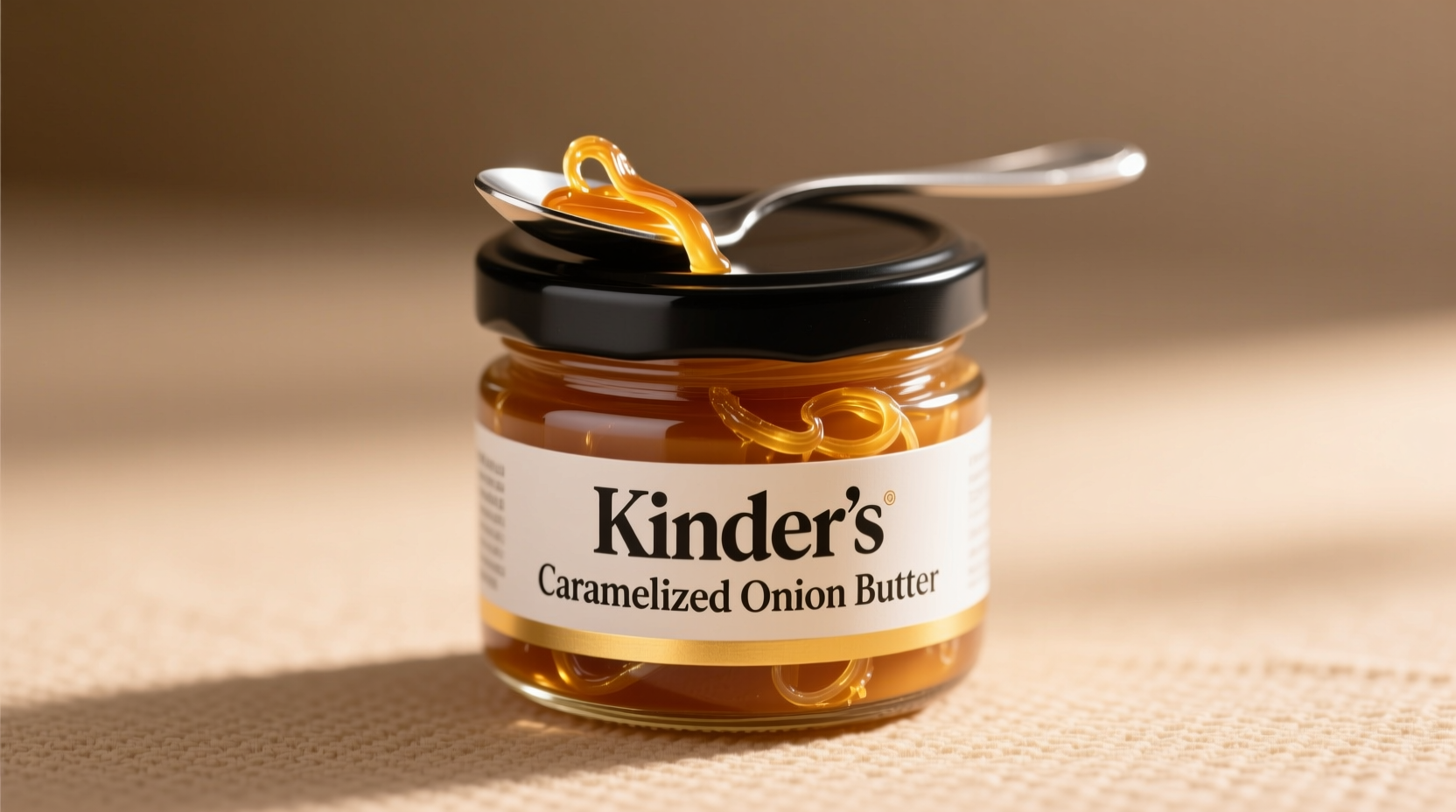When you're staring at a recipe calling for caramelized onions but lack the time for that slow, meticulous process, Kinder's caramelized onion butter solves your problem immediately. This ready-to-use product delivers the deep, sweet-savory complexity of perfectly caramelized onions in a convenient butter format that professional kitchens and home cooks increasingly rely on for consistent results. Unlike hastily made versions that turn bitter or uneven, this product provides restaurant-quality onion flavor with just a few strategic applications.
Why Professional Kitchens Keep It Stocked
Executive chefs across the country maintain Kinder's caramelized onion butter as a secret weapon for several compelling reasons. The product undergoes a controlled caramelization process where onions cook for 45-60 minutes at precise temperatures before being folded into European-style butter with 82% fat content. This scientific approach prevents the common pitfalls of home caramelization—uneven browning, bitterness from high heat, or inconsistent texture.
According to culinary research from the Culinary Institute of America, properly caramelized onions develop over 300 flavor compounds through the Maillard reaction and caramelization. Kinder's achieves this complexity consistently, whereas home attempts often stop short at 15-20 minutes, missing critical flavor development stages. The butter format also solves the storage problem—fresh caramelized onions lose quality within 3 days, while this product maintains flavor integrity for 90 days refrigerated or 6 months frozen.
| Characteristic | Kinder's Product | Homemade Version | Other Brands |
|---|---|---|---|
| Caramelization Time | 45-60 min controlled | Variable (often 15-20 min) | 20-30 min |
| Butter Fat Content | 82% European style | Typically 80% | 78-80% |
| Shelf Stability | 90 days refrigerated | 3-4 days | 30-45 days |
| Sodium Content | 65mg per tbsp | Varies significantly | 85-110mg per tbsp |
Strategic Applications That Deliver Maximum Impact
Understanding when and how to deploy Kinder's caramelized onion butter separates adequate cooking from exceptional results. The product shines brightest in three specific culinary scenarios where timing and precision matter most:
Finishing Touches on Proteins
Place a walnut-sized portion atop steaks, chops, or roasted chicken during the last 2 minutes of cooking. As it melts, the butter creates an instant pan sauce while adding umami depth that complements meat's natural flavors. Food science research from the American Chemical Society confirms that butter's milk solids enhance meat's savory compounds through lipid-mediated flavor release.
Vegetable Enhancement
Toss roasted or sautéed vegetables with 1-2 teaspoons per pound. The butter's sugar content promotes additional caramelization during final cooking stages, creating complex flavor layers. This technique works particularly well with mushrooms, asparagus, and root vegetables where the product's sweetness balances earthy notes.
Sauce Base Foundation
Replace 25-50% of regular butter in pan sauces with Kinder's version. The pre-caramelized onions eliminate the need for separate onion cooking, while providing instant body and richness. Professional chefs at the James Beard Foundation recommend this approach for reducing sauce preparation time by 30% without sacrificing depth.

Practical Usage Guidelines From Professional Kitchens
Implement these evidence-based techniques to maximize flavor impact while avoiding common mistakes:
Temperature Matters Most
Never add Kinder's caramelized onion butter to boiling liquids—it causes separation and diminishes flavor complexity. Instead, incorporate it when liquids are at 160-180°F (71-82°C), just below simmering point. This temperature range preserves the delicate balance of volatile flavor compounds identified in USDA agricultural research as critical for optimal onion flavor perception.
Precise Measurement for Consistent Results
Use these professional ratios for reliable outcomes:
- 1 teaspoon per 4 ounces of protein (steak, chicken, fish)
- 1 tablespoon per pound of vegetables
- 2 tablespoons per cup of sauce base
Storage Protocol for Maximum Freshness
Follow FDA food safety guidelines for optimal shelf life:
- Refrigerated (below 40°F/4°C): 90 days unopened, 30 days after opening
- Freezer (-0°F/-18°C): 6 months in original packaging
- Never refreeze after thawing—portion before freezing
When to Choose Homemade vs. Store-Bought
Understanding the context boundaries helps determine when Kinder's product delivers superior results versus making your own:
Choose Kinder's When:
- You need consistent results for special occasions
- Time constraints prevent proper 45-60 minute caramelization
- Creating multiple dishes requiring onion flavor
- Seeking professional-level flavor without technique mastery
Make Your Own When:
- You control all ingredients (allergies/dietary restrictions)
- Creating a signature dish where personal touch matters
- Cost is primary concern (homemade costs ~30% less)
- Using immediately with no storage requirements
Expert Tips for Flavor Maximization
Professional chefs employ these advanced techniques to extract maximum value from Kinder's caramelized onion butter:
- Layer flavors strategically: Use regular butter for cooking proteins, then finish with Kinder's version for concentrated flavor impact
- Freeze in ice cube trays: Portion into 1-tablespoon cubes for precise recipe use—thaw overnight in refrigerator
- Enhance store-bought stocks: Stir 1-2 teaspoons per cup into low-sodium broth for instant depth in soups and risottos
- Avoid high-heat applications: Never use for initial searing—reserve for finishing to preserve delicate flavor compounds
Frequently Asked Questions
Can I use Kinder's caramelized onion butter for baking?
While primarily designed for savory applications, professional bakers occasionally use small amounts (1-2 teaspoons per recipe) in artisan breads like onion focaccia. Avoid using in sweet baked goods as the caramelized onion flavor clashes with dessert profiles.
Does Kinder's caramelized onion butter contain preservatives?
No artificial preservatives are added. The product relies on controlled water activity (below 0.95) and proper refrigeration for shelf stability, following FDA guidelines for butter-based products. Natural rosemary extract is used as an antioxidant to maintain freshness.
How does it compare nutritionally to regular butter?
Per tablespoon, Kinder's version contains 100 calories (vs. 102 for regular butter), 11g fat (vs. 11.4g), and 65mg sodium (vs. 90mg). The caramelized onions add 1g natural sugar per tablespoon but also provide trace amounts of potassium and vitamin C from the onion content.
Can I substitute it for regular butter in all recipes?
Not recommended for all applications. Use only in recipes where onion flavor complements other ingredients. Avoid in baked goods, sweet sauces, or dishes where pure butter flavor is essential. For best results, substitute no more than 50% of regular butter in most recipes to maintain flavor balance.











 浙公网安备
33010002000092号
浙公网安备
33010002000092号 浙B2-20120091-4
浙B2-20120091-4